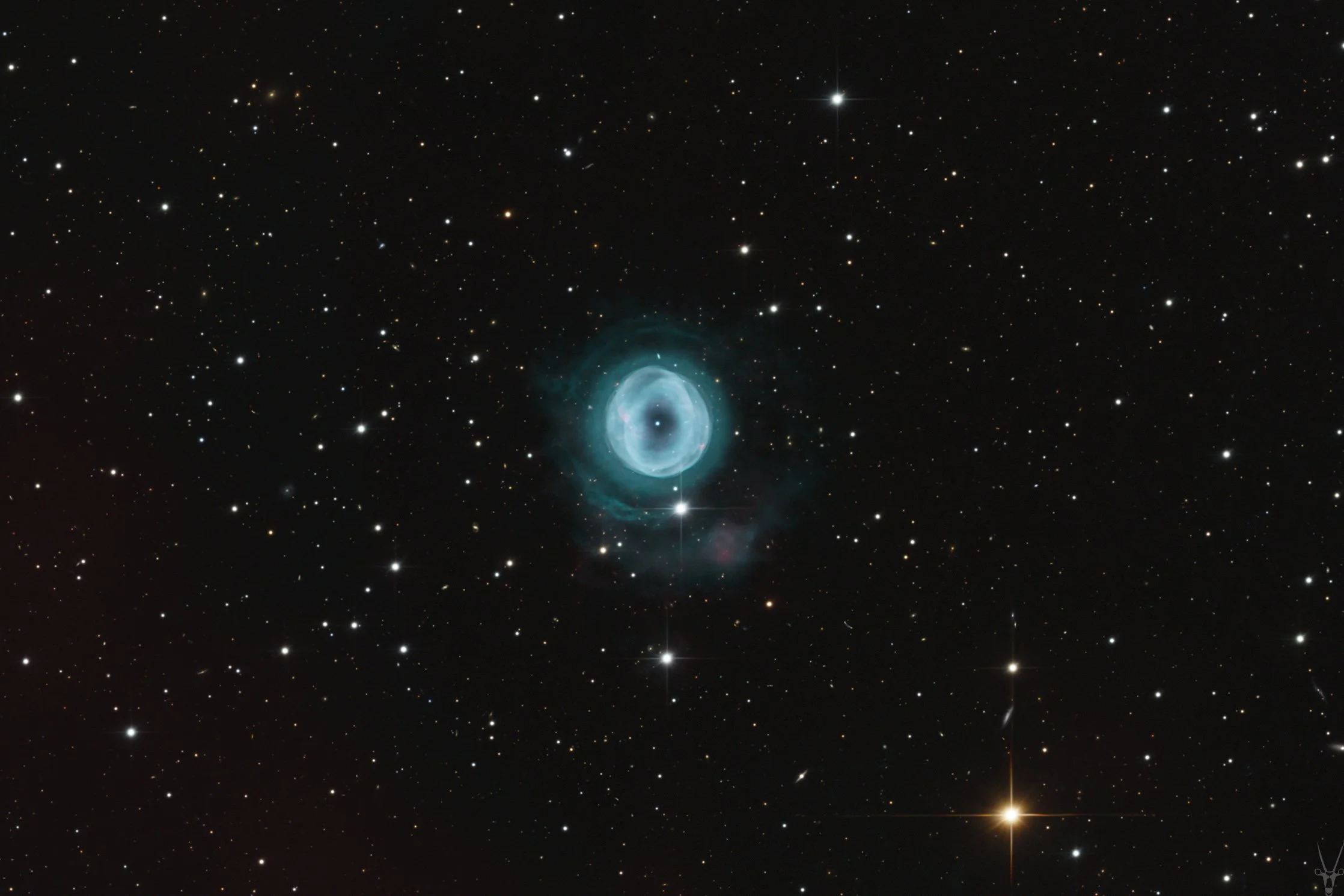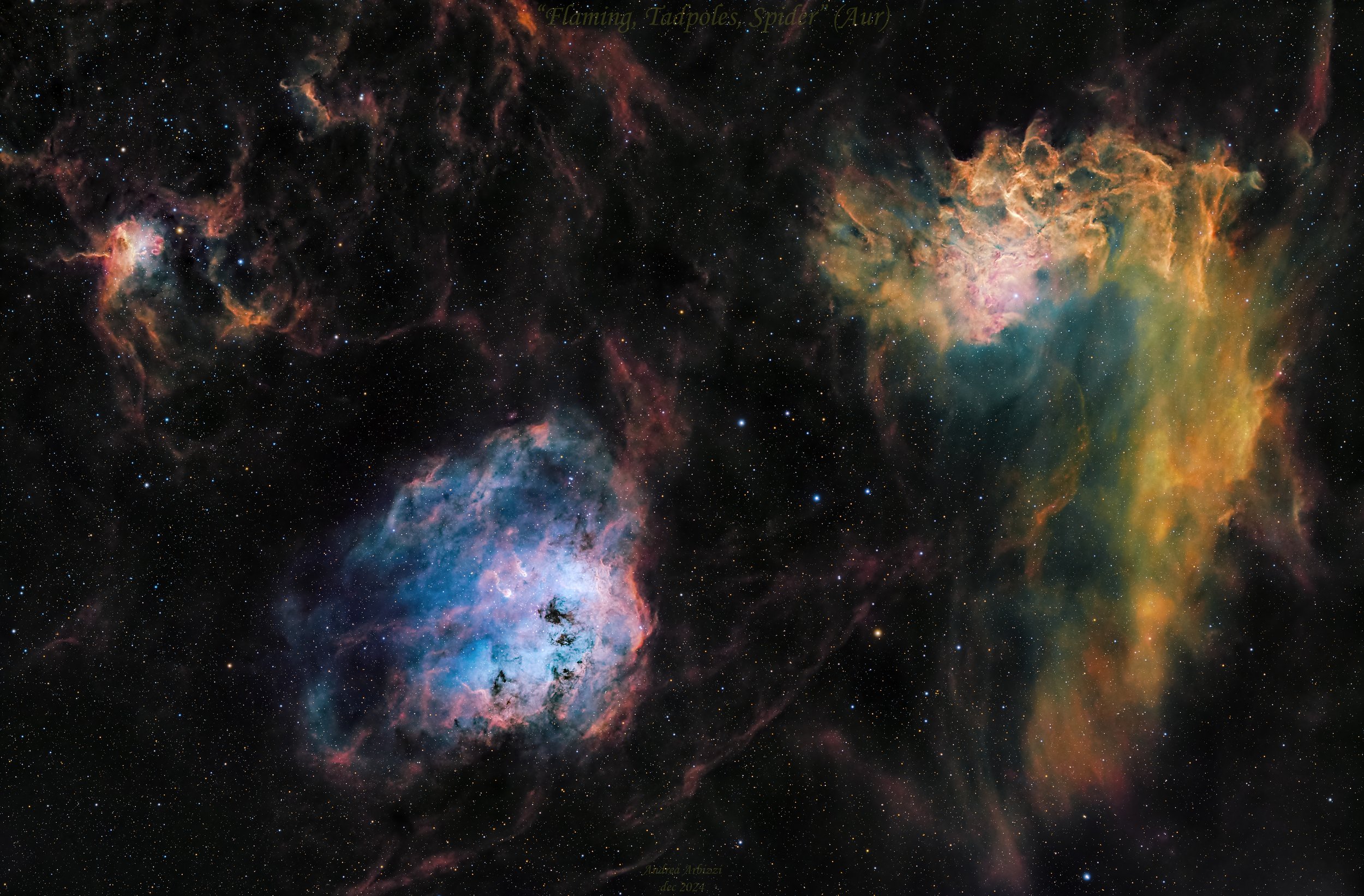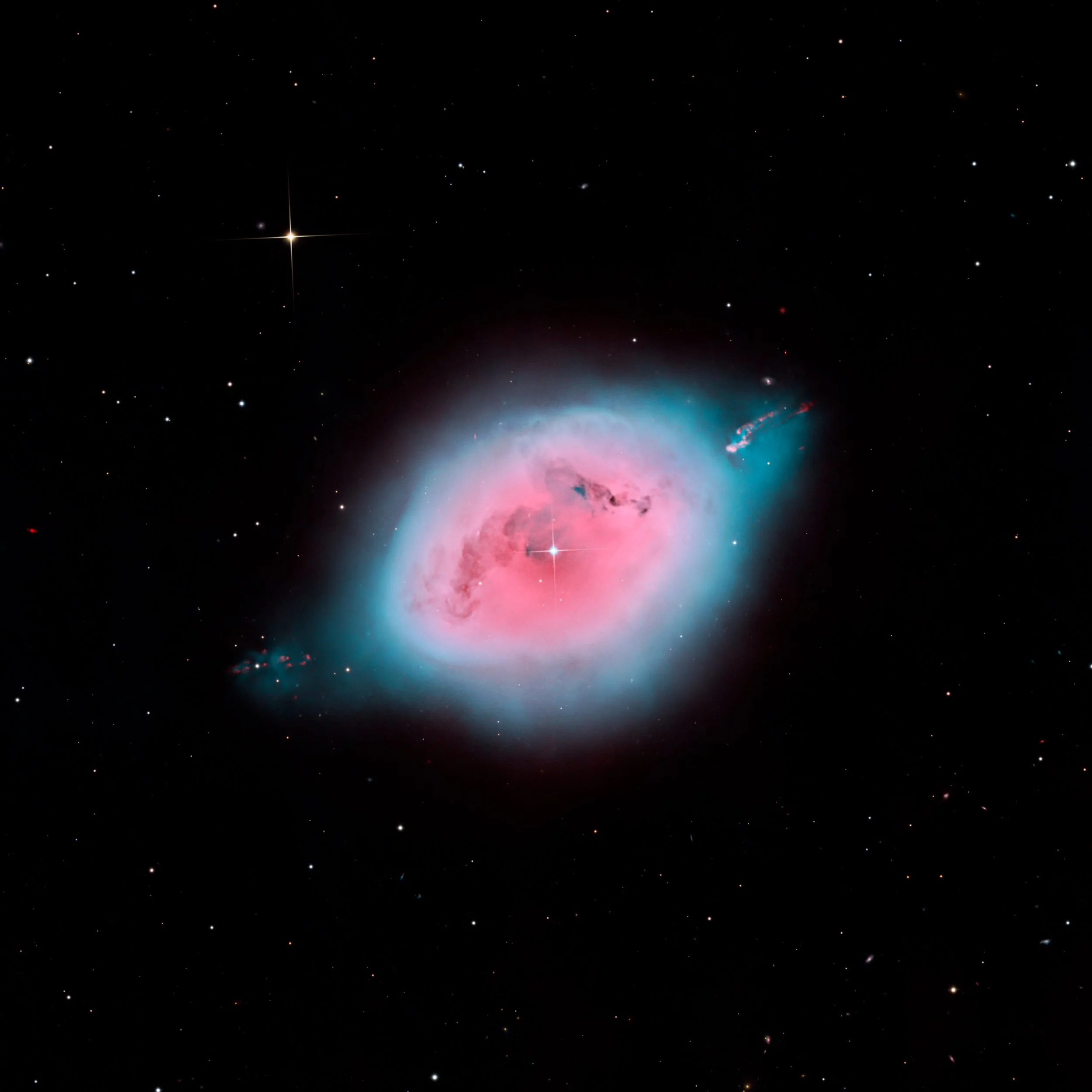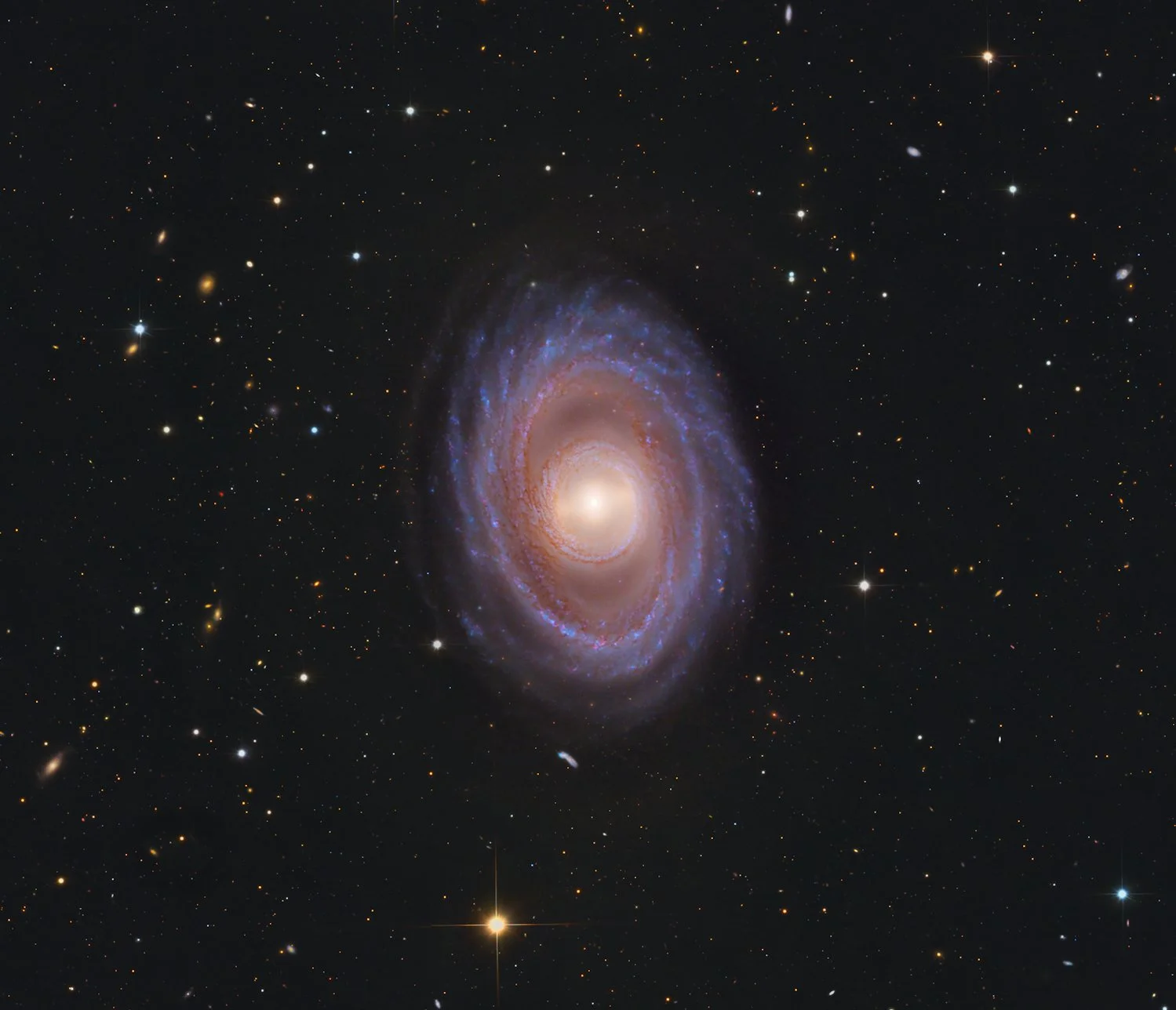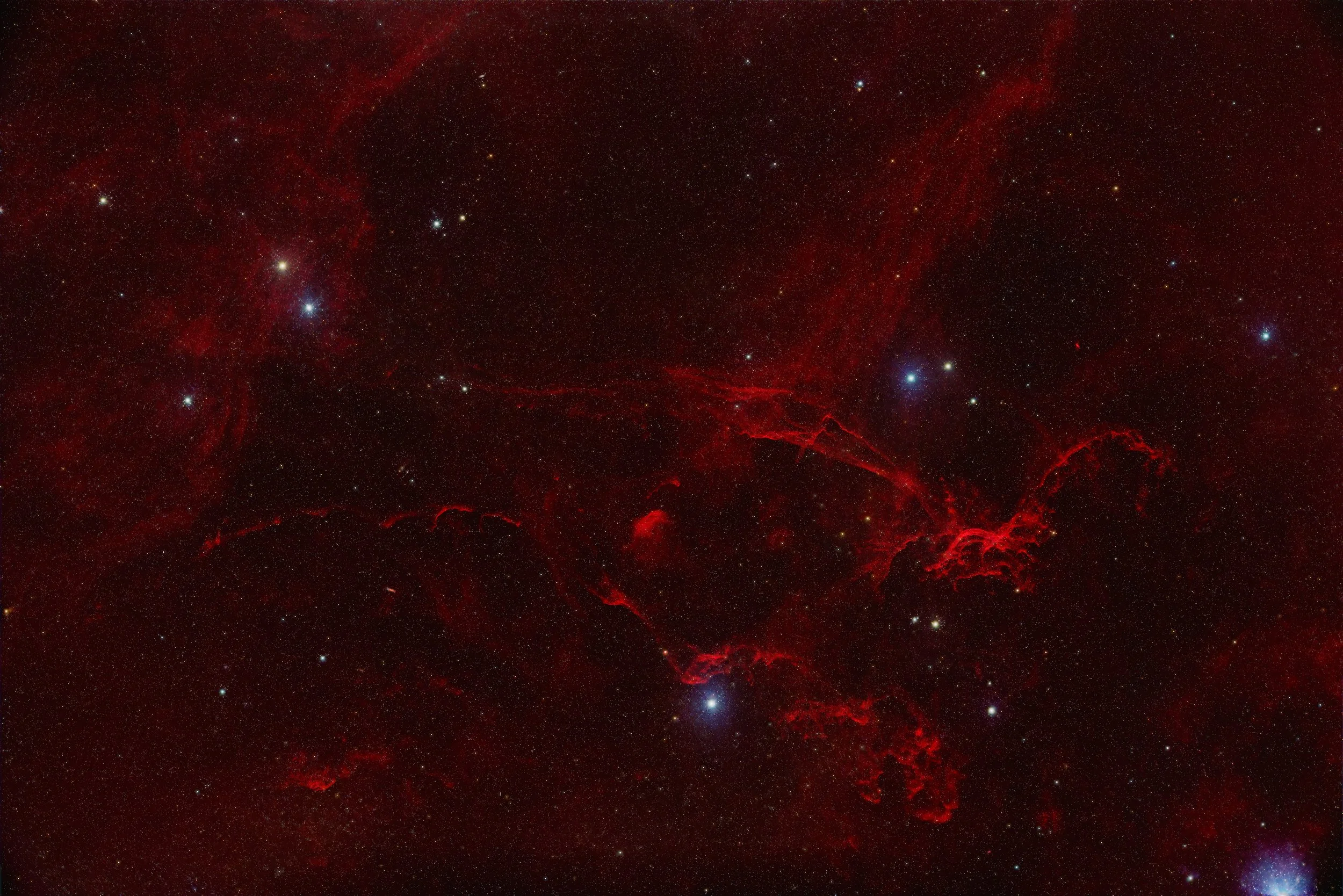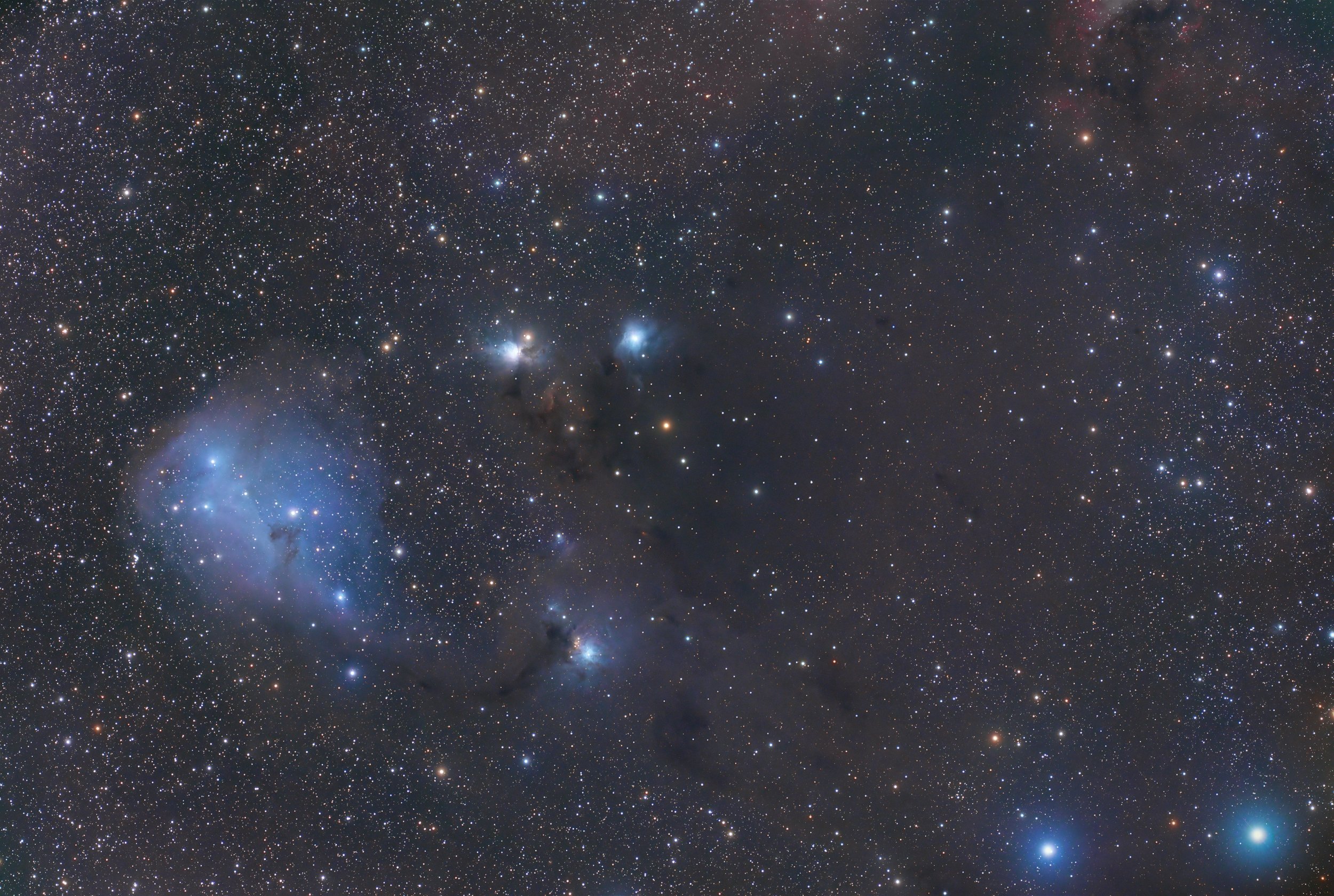
AAPOD2 Image Archives
NGC1333
NGC 1333, a vibrant reflection nebula in the Perseus molecular cloud, lies approximately 1,000 light-years away. This stellar nursery is a hotbed of star formation, with newborn stars illuminating the surrounding gas and dust. The nebula’s bluish hue arises from the scattered light of these young stars, while embedded pockets of dark, dusty material hint at regions still collapsing under gravity to form new stellar systems.
Observed from Biars-sur-Cère in Occitanie, France, NGC 1333 offers a glimpse into the chaotic early stages of star birth. This region is teeming with energetic phenomena, including jets and outflows from protostars, which carve intricate structures into the surrounding material. Despite its relative proximity, the nebula remains a challenge for observers, requiring dark skies to fully appreciate its intricate blend of light and shadow—a dynamic portrait of cosmic creation.
IC 5148
IC 5148, known as the Spare Tire Nebula, is a planetary nebula about 3,000 light-years away in the constellation Grus. This stunning object represents the final stages of a Sun-like star, shedding its outer layers as it transitions into a white dwarf. One of the fastest-expanding planetary nebulae known, its gas shell moves outward at an impressive 50 kilometers per second. The nebula's delicate, circular structure, with hues dominated by ionized oxygen, glows as ultraviolet radiation from its central star energizes the ejected material.
Located at Namibia’s Gemsbock Observatory, within the Rooisand Desert Ranch, IC 5148 benefits from some of the clearest skies on Earth, free of light pollution and ideal for deep-sky observation. Its faint, ethereal beauty is best captured under these pristine conditions, revealing its layered complexity and relatively young age of just a few thousand years. Discovered in the late 19th century, this celestial jewel offers a glimpse into the future of our Sun and the cyclical nature of stellar life in the cosmos.
Flaming star, Tadpole and Spider” nebulae
Flaming Star, Tadpole, and Spider Nebulae
In the heart of the winter Milky Way, the Flaming Star (IC 405), Tadpole (IC 410), and Spider (IC 417) nebulae form a mesmerizing trio of emission and reflection nebulae in the constellation Auriga. These celestial marvels lie between 10,000 and 12,000 light-years away, offering a glimpse into the interplay of star formation and interstellar gas. The Flaming Star Nebula, energized by the bright star AE Aurigae, combines glowing hydrogen gas and blue reflection nebulae in a captivating display. Meanwhile, IC 410, home to the “Tadpoles,” showcases dense star-forming regions resembling their namesake creatures, shaped by stellar winds.
The Spider Nebula, IC 417, appears entwined with its companion, the Fly Nebula (NGC 1931), in a delicate dance of gas and dust illuminated by young, massive stars. Observed under light-polluted skies in Modena, Italy (SQM 18.4–18.8, Bortle 7.5–8), these nebulae challenge astrophotographers with their faint, intricate structures. Yet even here, the brilliance of this cosmic trio reminds us of the dynamic processes shaping the Milky Way, bridging vast distances with their light.
Sh2-224 -The Rice Hat nebula
Sh2-224: The Rice Hat Nebula
Sh2-224, whimsically nicknamed the Rice Hat Nebula, is a striking supernova remnant located in the constellation Auriga, roughly 14,000 light-years away. Its distinctive crescent-like shape, resembling a traditional rice hat, arises from the violent shockwaves and expanding shell of material left behind by a massive star’s explosive death. The intricate structure of Sh2-224 is the result of its interaction with surrounding interstellar material, carving out bubbles and filaments as the shockwave propagates outward.
Observed from Sabugo, Portugal, this faint and delicate remnant challenges observers under suburban skies. The nebula emits primarily in hydrogen-alpha light, revealing its glowing, reddish hues and intricate arcs. Sh2-224 is not just a visual marvel but also a glimpse into the power of supernovae, which seed the cosmos with heavy elements and drive the evolution of galaxies.
The Fly and The Spider
The Fly and The Spider Nebulae
Entwined in the constellation Auriga, the Spider Nebula (IC 417) and its smaller companion, the Fly Nebula (NGC 1931), form a fascinating pair of emission nebulae approximately 10,000 light-years away. The Spider’s sprawling, web-like filaments are regions of active star formation, shaped by stellar winds and radiation from its young, massive stars. Nearby, the compact Fly Nebula glows brightly, its core a mix of reflection and emission nebulae surrounding a dense cluster of newborn stars.
Captured from Strakonice, Czech Republic, these nebulae present a stunning contrast: the Spider’s sprawling, diffuse arms versus the Fly’s bright, concentrated glow. Together, they illustrate the dynamic processes at work in stellar nurseries, where gravity and radiation sculpt the interstellar medium into these complex, ethereal forms. Despite the light pollution, their intricate beauty shines through as a testament to the creativity of the cosmos.
The Sun after its maximum
This captivating mosaic of the Sun, composed of five meticulously aligned panels, offers a glimpse of our star as it begins to settle into a quieter phase following its solar maximum. The intricate textures of the solar surface, including active regions, sunspots, and swirling plasma, are captured in extraordinary detail. The dynamic chromosphere reflects the Sun’s immense power, even as it transitions to a more subdued state in its 11-year solar cycle.
What better way to celebrate the start of a New Year than by looking at the cosmic powerhouse that sustains life on Earth? Just as the Sun begins its gradual decline in activity, the arrival of January invites us to reflect on cycles of change and renewal in our own lives.
NGC 1360: The Robin’s Egg of the Cosmos
Delicate and luminous, the Robin's Egg Nebula (NGC 1360) graces the constellation Fornax, offering a perfect symbol for New Year’s Day. Like the fragile egg it resembles, this planetary nebula represents new beginnings and infinite potential—a celestial reminder of the opportunities the year ahead holds.
Its soft blue glow comes from ionized gas, ejected by a dying star at its center, creating an elegant elliptical shape. This quiet transformation reflects the cycles of life and time, as one chapter ends and another begins.
Just as a robin’s egg protects the promise of new life, NGC 1360 invites us to look forward with hope and wonder, embracing the beauty and possibility of a fresh start under the vast expanse of the cosmos.
NGC6888 -The Crescent Nebula
Lighting up the constellation Cygnus, the Crescent Nebula (NGC 6888) shines like cosmic fireworks, a fitting farewell to the year that was. This glowing arc of gas and dust is the product of a massive Wolf-Rayet star nearing the end of its life. Intense stellar winds collide with material shed from the star’s earlier phases, sculpting this vibrant and dynamic structure.
Its fiery hues and intricate filaments mirror the brilliance of a midnight celebration, where endings and beginnings collide in a dazzling display. Spanning about 25 light-years, the Crescent Nebula serves as a reminder that even as one chapter closes, the universe is always creating something new and beautiful.
From all of us at AAPOD2, Happy New Year to our amazing members! May the year ahead be filled with clear skies, stunning captures, and endless wonder. 🌌✨
WR 134 region
In the constellation Cygnus, the brilliant Wolf-Rayet star WR 134 casts its influence across the cosmos, sculpting a stunning bubble of ionized gas that glows like a delicate cosmic wreath. This celestial feature is a powerful testament to the dynamic life cycles of massive stars.
The nebula’s faint yet intricate arcs, shaped by intense stellar winds, symbolize the beauty of transformation and renewal—an ideal image to ring in the new year. WR 134 serves as a reminder that even the most tumultuous forces can create breathtaking works of art in the universe, echoing themes of resilience and the promise of fresh beginnings.
As the new year dawns, this cosmic masterpiece invites us to marvel at the wonders of change and embrace the possibilities that lie ahead, just as the stars shape and reshape the cosmos around them.
Sh2-240 The Spaghetti Nebula
Stretching across the constellation Taurus, Sh2-240, also known as the Spaghetti Nebula, is a breathtaking remnant of a supernova explosion that occurred over 40,000 years ago. Its intricate, filamentary structure weaves a delicate tapestry of gas and dust, glowing faintly as it expands through the void.
The Spaghetti Nebula is a fitting symbol for New Year's Day, representing the passage of time and the interconnected nature of the universe. Its soft, ethereal tendrils remind us that even in the aftermath of explosive endings, beauty and transformation can emerge, weaving together the threads of the past and the promise of the future.
As we gaze at this cosmic masterpiece, it inspires us to reflect on our own journey through time and look forward to the new paths that await in the year ahead.
IC1848 Soul Nebula
Radiating with celestial energy, the Soul Nebula (IC 1848) shines brilliantly in the constellation Cassiopeia. This sprawling emission nebula, captured in the iconic SHO (Hubble) palette—where sulfur, hydrogen, and oxygen are mapped to striking gold, green, and blue hues—highlights the intricate details of this stellar nursery.
Made famous by the Hubble imaging team, the nebula’s vivid colors and textures resemble a beating heart, earning it the soulful moniker. Within its glowing depths, massive clouds of ionized gas fuel the birth of new stars, while darker regions of dust weave delicate shadows across the cosmic canvas.
The Soul Nebula is more than a celestial landmark; it’s a testament to the creative forces of the universe, showcasing the beauty and life hidden within the vastness of space.
NGC 1333, Barnard 203, Barnard 204: A dusty view of Perseus
Deep in the constellation Perseus, a cosmic tableau unfolds, featuring the star-forming region NGC 1333 and the dark nebulae Barnard 203 and Barnard 204. This stunning view is dominated by rich, dusty filaments that weave through the scene, creating a stark contrast against the faint glow of scattered starlight.
NGC 1333, nestled to the left, teems with youthful stars hidden within veils of gas and dust, their energetic outflows sculpting the surrounding material. Meanwhile, Barnard 203 and 204 cast inky shadows across the image, standing as quiet sentinels in this dynamic environment.
Together, these structures offer a breathtaking glimpse into the interplay of light and shadow, showcasing the raw materials of star formation and the intricate beauty of the cosmos.
The Seven Sisters
Rising high on Christmas Day, the Pleiades star cluster (M45), known as the Seven Sisters, graces the heavens with a festive glow. In this image, the cluster is framed vertically, resembling a sparkling celestial Christmas tree. The bright blue stars, adorned with wisps of reflection nebulae, form a striking "ornamented" structure against the dark backdrop of space, as if dusted with cosmic snow.
This seasonal alignment invites us to look skyward and reflect on the beauty and wonder of the universe. Much like the spirit of the holidays, the Pleiades reminds us of connection and light, shining brightly as a timeless symbol of hope and renewal.
SH2-278
Nestled in the constellation Orion, SH2-278 is a captivating emission nebula that tells a story of star birth and interstellar artistry. The nebula is dominated by glowing hydrogen-alpha emissions, painting vibrant red hues across the region. Complementing this are stunning blue regions, indicative of reflection nebulae—dust clouds illuminated by the scattered light of nearby stars.
In the left center of the image, delicate structures known as Herbig-Haro objects make an appearance. These rare features are formed when streams of ionized gas from newborn stars collide with surrounding clouds of gas and dust, creating intricate, luminous jets. SH2-278 is a testament to the dynamic processes shaping the cosmos, offering a glimpse into the beauty and complexity of our universe.
Orion's Belt
The Orion's Belt is formed by the three bright stars Alnitak, Alnilam, and Mintaka, aligned in a nearly straight line within the constellation Orion, about 1,300 light-years from Earth. These stars are massive blue supergiants, each much larger and hotter than the Sun, shining brightly due to their intense luminosity and surface temperatures.
In a wide-field image of the belt, you can also observe surrounding interstellar material, such as the Flame Nebula near Alnitak and the Horsehead Nebula, a dark silhouette against a glowing background of hydrogen gas. The region is part of the Orion Molecular Cloud Complex, a massive star-forming area rich with gas and dust. The alignment and brightness of these three stars have made Orion's Belt a key feature for stargazers across cultures throughout history.
SH2-308 Dolphin Head Nebula
The Dolphin's Head Nebula (Sh2-308) is an emission nebula located in the constellation Canis Major, approximately 4,500 light-years away. This bubble-shaped nebula is created by the strong stellar winds from the Wolf-Rayet star EZ Canis Majoris (WR 6), a massive, dying star in the final stages of its life.
The nebula spans about 60 light-years across, with its faint glow originating from ionized hydrogen gas illuminated by the ultraviolet radiation of the central star. Sh2-308 is an example of a Wolf-Rayet bubble, a structure formed when stellar winds sweep up the surrounding material. It is a fleeting structure in astronomical terms, lasting only a few hundred thousand years before dissipating into space.
The Dreyer's Nebula Complex
Dreyer's Nebula (IC 447) is a striking reflection nebula located in the constellation Monoceros, about 3,000 light-years away. It forms one end of the Monoceros R1 star-forming filament, with IC 446 at the opposite end. IC 447 reflects the light of nearby young, hot stars embedded in the surrounding dust, causing its characteristic blue glow.
Nearby, NGC 2245 and NGC 2247, two additional reflection nebulae, are part of this complex region of active star formation. On the right side of the image lies the edge of an extended hydrogen emission region associated with the Cone Nebula and Christmas Tree Cluster, highlighting the dynamic interactions between gas, dust, and young stellar populations in this vibrant stellar nursery.
NGC 1398 - A Spiral Beauty in Fornax
NGC 1398, a stunning barred spiral galaxy located in the constellation Fornax, lies approximately 65 million light-years from Earth. Its defining features include a prominent bar structure and tightly wound spiral arms, creating a breathtaking cosmic masterpiece.
This galaxy is a true gem of the night sky, showcasing a wealth of intricate details that challenge even the most experienced astrophotographers. With this image, I aimed to capture those details with precision, revealing the beauty and complexity of this distant treasure.
The Flying Dragons - Sh2-114, LBN347 (Ha-RGB)
The image of Sh2-114, (and 113) known as the "Flying Dragon Nebula," is a stunning example of cosmic artistry. The intricate red filaments of ionized hydrogen stretch across the field, resembling the fiery wings of a mythical dragon. The interplay of glowing red nebular gas against the dark, star-filled background creates a sense of depth, highlighting the delicate, web-like structures sculpted by stellar winds and magnetic fields.
Astronomically, Sh2-114 is a Sharpless catalog emission nebula located in the constellation Cygnus. Its fiery hues stem from hydrogen atoms energized by ultraviolet radiation from nearby stars. This nebula’s complexity reflects the dynamic forces at play, and the only emission from these nebulae is in Ha frequency (check this link for a comprehensive explanation) and so is the "clouds" around the objects.
Directly above the right wing, halfway between the wing and the edge of the frame, is a planetary nebula. This is cataloged as Kronberger (Kn26), and it is a bipolar emission nebula. Kn26 is a small (110 arc seconds) planetary nebula in the constellation Cygnus. Kn26 was discovered by Austrian amateur astronomer Matthias Kronberger in 2006, although it wasn't spectroscopically confirmed as a planetary nebula until 2011. In 2012 it was established that it was a new member of the very small sub-class of quadupolar planetary nebulae.The image of Sh2-114, (and 113) known as the "Flying Dragon Nebula," is a stunning example of cosmic artistry. The intricate red filaments of ionized hydrogen stretch across the field, resembling the fiery wings of a mythical dragon. The interplay of glowing red nebular gas against the dark, star-filled background creates a sense of depth, highlighting the delicate, web-like structures sculpted by stellar winds and magnetic fields.
Astronomically, Sh2-114 is a Sharpless catalog emission nebula located in the constellation Cygnus. Its fiery hues stem from hydrogen atoms energized by ultraviolet radiation from nearby stars. This nebula’s complexity reflects the dynamic forces at play, and the only emission from these nebulae is in Ha frequency (check this link for a comprehensive explanation) and so is the "clouds" around the objects.
Directly above the right wing, halfway between the wing and the edge of the frame, is a planetary nebula. This is cataloged as Kronberger (Kn26), and it is a bipolar emission nebula. Kn26 is a small (110 arc seconds) planetary nebula in the constellation Cygnus. Kn26 was discovered by Austrian amateur astronomer Matthias Kronberger in 2006, although it wasn't spectroscopically confirmed as a planetary nebula until 2011. In 2012 it was established that it was a new member of the very small sub-class of quadupolar planetary nebulae.



